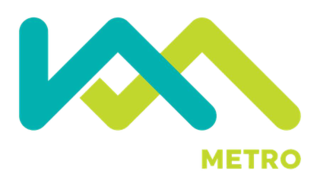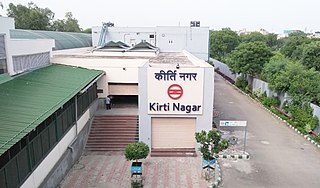
The Mumbai Metro is a rapid transit (MRT) system serving the city of Mumbai and the wider Mumbai Metropolitan Region in Maharashtra, India.

The Red Line is a metro rail line of the Delhi Metro, a rapid transit system in Delhi, India. It is mostly an elevated line and has 29 stations that runs from Rithala to Shaheed Sthal with a total distance of 34.55 km. The Tis Hazari – Shahdara section of this line was the first stretch of the Delhi Metro that was constructed and commissioned. The line connects the areas of Ghaziabad in Uttar Pradesh and the districts of Shahdara, Central Delhi and North West Delhi in Delhi.

Delhi has significant reliance on its transport infrastructure. The city has developed a highly efficient public transport system with the introduction of the Delhi Metro, which is undergoing a rapid modernization and expansion since 2006. There are 16.6 million registered vehicles in the city as of 30 June 2014, which is the highest in the world among all cities, most of which do not follow any pollution emission norm, while the Delhi metropolitan region has 11.2 million vehicles. Delhi and NCR lose nearly 42 crore man-hours every month while commuting between home and office through public transport, due to the traffic congestion. Therefore, serious efforts, including a number of transport infrastructure projects, are under way to encourage usage of public transport in the city.

The Kochi Metro is a rapid transit system serving the city of Kochi and the wider Kochi Metropolitan Region in Kerala, India. It was opened to the public within four years of starting construction, making it one of the fastest completed metro projects in India. The Kochi metro project is the first metro system in the country which connects rail, road and water transport facilities. It is also the first metro rail system in India to be operated using the Communication-Based Train Control (CBTC) signalling system, which requires minimum human intervention. The Kochi Water Metro is integrated with the Kochi Metro, which also serves as a feeder service to the suburbs along the rivers where transport accessibility is limited.

Pune Metro is a mass rapid transit system serving the city of Pune, India. The system comprises 3 lines with a combined length of 54.14 km (33.64 mi), of which 24.12 km (14.99 mi) on two lines are operational as of August 2023. The extended metro line from Ruby Hall Clinic to Ramwadi, including the Bund Garden, Kalyani Nagar and Ramwadi metro stations, covering a distance of 6 km, was inaugrated on 6 March 2024. The 16.59 km (10.31 mi) Purple Line from PCMC Bhavan to Swargate runs on an elevated viaduct between PCMC Bhavan to Range Hills, from where it goes underground. The Aqua Line runs from Vanaz to Ramwadi covering a distance of 14.66 km (9.11 mi) on an elevated viaduct. The 23.33 km (14.50 mi) elevated Line 3 will run from the Rajiv Gandhi Infotech Park in Hinjawadi via Balewadi to Civil Court. All three lines will align at the Civil Court interchange station.

The Lucknow Metro is a mass rapid transit (MRT) system in Lucknow, Uttar Pradesh, India. The metro is owned and operated by the Uttar Pradesh Metro Rail Corporation (UPMRC). The frequency of the metro's services is around 5 - 7 minutes.

The Green Line is a metro rail line of the Delhi Metro, a rapid transit system in Delhi, India. The line consists of 24 stations covering a total length of 28.79 km. It runs between Inderlok and Brigadier Hoshiyar Singh with a branch line connecting the line's Ashok Park Main station with Kirti Nagar station.

Urban rail transit in India plays an important role in intracity transportation in the major cities which are highly populated. It consists of rapid transit, suburban rail, monorail, and tram systems.

The Kirti Nagar metro station is an interchange station between the Blue Line and Green Line of Delhi Metro. It is one of the eastward terminal stations of the Green Line, the other being Inderlok, and was opened as a part of a small 3.41 km (2.12 mi) branch from this station to Ashok Park Main station on 27 August 2011. This allowed passengers to easily transfer between the Red Line and Blue Line of the network.

The Bhoj Metro is an under construction rapid transit system intended to serve the city of Bhopal, India, the capital of the Indian state of Madhya Pradesh. The total system consists of 6 corridors covering a distance of 104.87 kilometres (65.16 mi). The first phase of the Bhopal Metro project consists of 28 km (17.40 mi) of line 2 & 5 being under construction. This project will cost ₹80 billion (US$960 million) approximately. There will be three types of run – on road, on bridges, and underground in some locations.

The Delhi Metro is a mass rapid transit system which serves Delhi and its adjoining satellite cities, such as Ghaziabad, Faridabad, Gurugram, Noida and Bahadurgarh, in the National Capital Region of India. The system consists of 10 colour-coded lines serving 256 stations, with a total length of 350.42 kilometres (217.74 mi). It is India's largest and busiest metro rail system and the second-oldest, after the Kolkata Metro. The metro has a mix of underground, at-grade, and elevated stations using broad-gauge and standard-gauge tracks. The metro makes over 4,300 trips daily.

The Indore Metro is a rapid transit system which is under construction for the city of Indore, in the state of Madhya Pradesh, India. The total system consists of 11 corridors (lines) covering a distance of 124 kilometres (77 mi). This project will cost approximately ₹12,000 crore (US$1.4 billion). The cost per km will be 182 crores and total cost is 15,000 crores. The metro system will be elevated, underground and on ground. The Indore Metro project has been subject to serious contestation due to the inappropriate shifting of Seismic zone-II to Seismic zone-IV category which has led to increase in budgetary cost for the entire project.

The Noida Metro is a rapid transit system connecting the twin cities of Noida and Greater Noida in Gautam Buddh Nagar, Uttar Pradesh, India. The metro network consists of one line, with a total length of 29.7 kilometres (18.5 mi) serving 21 stations. The system has all elevated stations using standard-gauge tracks.
The Srinagar Metro is a light rail transit planned for the city of Srinagar, Jammu and Kashmir. The plans for the Srinagar Metro have been finalised with the work expected to start once the project gets nod from union cabinet. The proposed network will have two corridors. Each corridor of Srinagar metro will have 12 stations each with the total cost expected to be ₹5,559 crore.

The Pink Line is a metro rail line of the Delhi Metro, a rapid transit system in Delhi, India. It consists of 38 metro stations from Majlis Park to Shiv Vihar, both in North Delhi.

The Magenta Line is a metro rail line of the Delhi Metro, a rapid transit system in Delhi, India and the first driverless metro in India.The line is laid on most of the parts of South Delhi and is mostly underground.The total length of the line is 37.46 kilometers (23.28 mi) and it consists of 25 metro stations from Janakpuri West to Botanical Garden, out of which 10 are elevated and the rest are underground. Unlike the Airport Metro Express, this line directly serves Terminal 1 of the Indira Gandhi International Airport.
The Brown Line is an approved line of the Delhi Metro. It will provide improved direct connections to eastern, southern and south-eastern Delhi with the Indira Gandhi International Airport and Faridabad to decrease the increasing traffic, congestion and pollution on roads. It will act as a link line, by joining four lines–Violet, Pink, Magenta and Golden lines with each other. It will start from Lajpat Nagar and end in Saket G-Block. It will be 7.96 km (4.95 mi) long with eight stations, all of which will be elevated. The line was approved by the Government of India and the foundation stone was laid for its construction by Prime Minister Narendra Modi on 14 March 2024, and work is yet to begin, as part of the fourth phase of the Delhi Metro's development. The line is slated to be completed by March 2026.

The Indraprastha Extension metro station is located on the Pink Line of the Delhi Metro.
The Delhi Metroneo is a planned 19.09 km (11.86 mi) Metrolite system with 21 stations that will connect Kirti Nagar to Bamnoli Village via Mayapuri, Hari Nagar, Tihar Jail, Dwarka Sector 2, Sector 7, Sector 6, Sector 20, and Sector 23, and the Dwarka ECC.Earlier the corridor was planned as a Metrolite but in November 2020, the project was cancelled, replacing the corridor with Metro Neo by the DMRC officials. It will be designed as per MoHUA's Metrolite specifications, and will be much cheaper to construct because of its lower speeds and carrying capacities compared to regular metros. Detailed Project Report (DPR) for this line was approved by DMRC's board in October 2019, and is currently awaiting the Delhi Government's approval.
The Golden Line(Line 10) is an under-construction rapid transit line of the Delhi Metro. It will connect southern Delhi directly with Indira Gandhi International Airport to relieve the increasing traffic, congestion and pollution on roads. It will start from Terminal 1-IGI Airport, which was previously planned from Delhi Aerocity, and end in Tughlakabad. It will be 25.82 km (16.04 mi) long with 16 stations, out of which four will be elevated and 12 will be underground. Construction began on the line in June 2022, as part of the fourth phase of the Delhi Metro's development, and is expected to be completed by March 2026.













